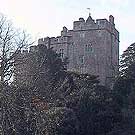Dunster Castle

Base layers
Data layers

Other Images
Venue Type & Location
Site Name: Dunster Castle
Location: Dunster Castle
County: Somerset
Location Type: Countryside - at determined location
Overview
Located in a defensive site high on a tor near the steep N coast of Somerset and the Devon border with magnificent views of the Exmoor uplands.
Little survives of the medieval fortification apart from a late 13th c. twin-towered gateway to the Lower Ward and an early 14th c. gatehouse on the N side. After several centuries of remodelling, Dunster Castle remains a handsome renovation by medievalizing Victorians.
Performance History
Probable performance venue. Although relevant family records do not survive, Sir Hugh Luttrell's entertainer(s) are recorded in the neighbouring county of Devon in the early 15th c.
Current Status
National Trust property open to the public at specified times.
History of the Venue
11th c. Motte and bailey castle built by William de Mohun.
early 13th c. Gateway to Lower Ward built.
1376 Elizabeth, widow of Sir Andrew Luttrell of Chilton, bought Dunster from Joan de Mohun.
1405 Sir Hugh Luttrell took up residence, making necessary repairs.
1420 Sir Hugh Luttrell built the outer gatehouse in the Lower Ward.
1460 Sir James Luttrell killed in the Battle of St Albans. Lands seized and given to the Yorkist Sir William Herbert.
1485 Luttrells resumed ownership of Dunster.
Early 16th c. Buildings in the Upper Ward (former keep) deteriorating.
16th c. Thomas Luttrell converted the castle as a 3-storey residence, keeping the curtain wall and 2 towers.
late 16th c. George Luttrell repaired the walls and house interior.
1617 William Arnold designed a new H-plan Jacobean house for George Luttrell, incorporating much of the older fabric.
1645 Castle beseiged by parliamentary army.
1646--51 Garrisoned by parliamentary forces.
1650 Walls and buildings around the keep demolished by order of parliament.
1680--90 Some remodelling done by Francis Luttrell. House uninhabited for a period.
1720--3 New approach created from Dunster village around the E side of the hill by Dorothy Luttrell. Summer house and bowling green built on the top of the levelled tor and a chapel added against the S front.
1726--47 House placed in the hands of a receiver and closed up.
1747 Margaret Luttrell married her cousin Henry Fownes, who added Luttrell to his name and took up residence at Dunster. Redecoration in rococo style followed.
1764 Green Court created on the site of the sloping Lower Ward. Polygonal turrets added to the gatehouse.
1775 Grounds landscaped and a tower folly built on Conygar Hill for Henry Fownes Luttrell.
1868--72 Extensive remodelling in romanticized medieval style by Anthony Salvin for George Fownes Luttrell. New towers added and rooms remodelled within the existing walls. 18th c. chapel demolished.
1943--4 Dunster used as a convalescent home during World War II.
1949 Estate sold by Geoffrey Luttrell to the Ashdale Property Co., but the family was allowed to remain as tenants.
1954 Castle and environs sold back to the Luttrell family by the Commissioners of Crown Lands, which had acquired the property.
1976 Walter Luttrell gave the castle and most of its contents to the National Trust.
Record Source
REED Devon 90
Patrons who owned this venue
| Name | Dates | Titles |
|---|---|---|
| Luttrell, Hugh | 1364-1428 | Knight |
Bibliographic Sources
-
Buck, Samuel, and Nathaniel Buck. [A Collection of Engravings of the Castles, Abbeys, and Towns in England and Wales]. 5 vols. London: The authors, 1726–52.
-
Clark, G.T. 'Dunster Castle.' Archaeological Journal 36 (1879): 308–20.
-
Clark, George T. Mediaeval Military Architecture in England. 2 vols. London: Wyman & Sons, 1884.
-
Dunning, R.W. Some Somerset Country Houses. Wimborne: Dovecote P, 1991.
-
'Dunster Castle, Somerset: The Seat of Mr. G.F. Luttrell.' Country Life 14 (14 Nov. 1903): 686–94.
-
Harfield, C.G. 'A Hand-List of Castles Recorded in the Domesday Book' English Historical Review 106 (1991): 371–92.
-
Haslem, Richard. 'Dunster Castle, Somerset – II.' Country Life 181 (23 July 1987): 102–6.
-
Haslem, Richard. 'Dunster Castle, Somerset – I.' Country Life 181 (16 July 1987): 124–7.
-
King, David J. Cathcart. Castellarium Anglicanum: An Index and Bibliography of the Castles in England, Wales and the Islands. 2 vols. Millwood, NY, London and Nendeln, Liechtenstein: Kraus International Publications, 1983.
-
Mackenzie, James D. The Castles of England: Their Story and Structure. 2 vols. New York: The Macmillan Co., 1896.
-
The National Trust. Dunster Castle, Somerset. London: The National Trust, 2003.
-
Page, William, and R.W. Dunning, eds. The Victoria History of the County of Somerset. Victoria History of the Counties of England. 4 vols. London; Oxford: Constable [vols 1–2]; Oxford UP [vols 3–8], 1906–12 [vols 1–2]; 1974–2004 [vols 3–8].
-
Pevsner, Nikolaus. South and West Somerset. The Buildings of England. Harmondsworth, Midd: Penguin Books, 1976.
-
Somerset Fry, Plantagenet. Castles of the British Isles. New York: Dorset P, 1990.




